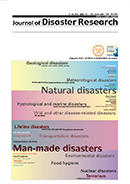Volume 15, Issue 6
Displaying 1-12 of 12 articles from this issue
- |<
- <
- 1
- >
- >|
Special Issue on NIED Frontier Research on Science and Technology for Disaster Risk Reduction and Resilience 2020
-
Article type: Editorial
2020Volume 15Issue 6 Pages 675
Published: October 01, 2020
Released on J-STAGE: October 01, 2020
Download PDF (164K) -
Article type: Paper
2020Volume 15Issue 6 Pages 676-687
Published: October 01, 2020
Released on J-STAGE: October 01, 2020
Download PDF (7829K) -
Article type: Paper
2020Volume 15Issue 6 Pages 688-697
Published: October 01, 2020
Released on J-STAGE: October 01, 2020
Download PDF (1985K) -
Article type: Paper
2020Volume 15Issue 6 Pages 698-711
Published: October 01, 2020
Released on J-STAGE: October 01, 2020
Download PDF (517K) -
Article type: Paper
2020Volume 15Issue 6 Pages 712-725
Published: October 01, 2020
Released on J-STAGE: October 01, 2020
Download PDF (4988K) -
Article type: Paper
2020Volume 15Issue 6 Pages 726-734
Published: October 01, 2020
Released on J-STAGE: October 01, 2020
Download PDF (3417K) -
Article type: Paper
2020Volume 15Issue 6 Pages 735-744
Published: October 01, 2020
Released on J-STAGE: October 01, 2020
Download PDF (6931K) -
Article type: Paper
2020Volume 15Issue 6 Pages 745-753
Published: October 01, 2020
Released on J-STAGE: October 01, 2020
Download PDF (491K) -
Article type: Paper
2020Volume 15Issue 6 Pages 754-764
Published: October 01, 2020
Released on J-STAGE: October 01, 2020
Download PDF (1155K) -
Article type: Paper
2020Volume 15Issue 6 Pages 765-781
Published: October 01, 2020
Released on J-STAGE: October 01, 2020
Download PDF (7614K)
Regular Papers
-
Article type: Paper
2020Volume 15Issue 6 Pages 783-793
Published: October 01, 2020
Released on J-STAGE: October 01, 2020
Download PDF (2520K) -
Article type: Paper
2020Volume 15Issue 6 Pages 794-801
Published: October 01, 2020
Released on J-STAGE: October 01, 2020
Download PDF (930K)
- |<
- <
- 1
- >
- >|
